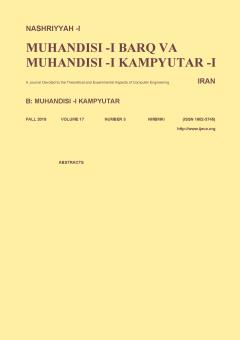An Efficient Approach to Reduce Energy Consumption in Internet of Things Routing
Subject Areas : مهندسی برق و کامپیوترM. Asgari 1 , M. Fathy 2 * , Mohammad Shahverdy 3 , M. Soheili Nayer 4
1 -
2 -
3 - University of Science and Technology
4 -
Keywords: Efficient energyfuzzy systemInternet of thingsrouting,
Abstract :
The Internet of Things (IOT) is a new concept in the area of monitoring information transmission and remote control of things, existents and equipment that has been able to adapt itself with different industries and substructures easily. The information transmission with regard to the non-homogenous environment of internet of things has been a challengeable topic and use of routing methods by considering the limitations of processing, calculating, saving and communicating has been known as a necessary issue. Various algorithms with special applications have been already introduced in the domain of internet of things and wireless sensor networks that each one somehow has been successful in achieving the routing goals. Some proposed protocols in this field have used a tree structure for gathering the network information. These methods in selecting the parent or children of graph are affected by important challenges depending on the type of application. In this paper, at first, a general classification of advantages and defects of recent methods has been done in the domain of routing the internet of things and then a routing method service quality awareness in routing based on fuzzy system has been suggested. The results of simulations and assessment express that the suggested method in the tests of energy productivity, delay ratio and data delivery ratio have better performance than the recent methods.
[1] S. Umamaheswari and A. Negi, "Internet of things and RPL routing protocol: a study and evaluation," in Proc. Int. Conf. on Computer Communication and Informatics, ICCCI'17, 7 pp., Coimbatore, India, 5-7 Jan. 2017.
[2] H. M. Xin and K. Yang, "Routing protocols analysis for internet of things," in Proc. 2nd Int. Conf. on Information Science and Control Engineering, ICISCE'15, pp. 447-450, Shanghai, China 24-26 Apr. 2015.
[3] Z. Sheng, S. Yang, Y. Yu, A. Vasilakos, J. McCann, and K. Leung, "A survey on the IETF protocol suite for the internet of things: standards, challenges, and opportunities," IEEE Wirel. Commun., vol. 20, no. 6, pp. 91-98, Dec. 2013.
[4] T. Zhang and X. Li, "Evaluating and analyzing the performance of RPL in contiki," in Proc. 1st Int. Workshop on Mobile Sensing, Computing and Communication, pp. 19-24, Philadelphia, PA, USA, 11-11 Aug. 2014.
[5] X. Vilajosana, P. Tuset, T. Watteyne, and K. Pister, "OpenMote: open-source prototyping platform for the industrial IoT," Ad Hoc Networks, pp. 211-222, San Remo, Italy, 1-2 Sept. 2015.
[6] D. Han and O. Gnawali, "Performance of RPL under wireless interference," Commun. Mag. IEEE, vol. 51, no. 12, pp. 137-143, Dec. 2013.
[7] A. Dhumane, R. Prasad, and J. Prasad, "Routing issues in internet of things: a survey," in Proc. Int. Multi Conf. of Engineers and Computer Scientists, IMECS'16, vol. 1, pp. 404-412, Hong Kong, China, 16-18, Mar. 2016.
[8] G. S. Rapat and N. C. Naveen, "A survey on routing protocols of internet of things," International J. of Innovative Research in Computer and Communication Engineering, vol. 6, no. 5, pp. 5892-5898, May 2018.
[9] R. K. Poluru and S. Naseera, "A literature review on routing strategy in the internet of things," J. of Engineering Science and Technology Review, vol. 10, no. 5, pp. 50-60, Sept. 2017.
[10] D. Airehrour, J. Gutierrez, and S. K. Ray, "Secure routing for internet of things: Aa survey," Journal of Network and Computer Applications, vol. 66, pp. 198-213, May.2016.
[11] B. Mohamed and F. Mohamed, "QoS routing RPL for low power and lossy networks," International J. of Distributed Sensor Networks, vol. 11, no. 11, pp. 1-10, Nov. 2015.
[12] J. Wang and H. Li, "Researching and hardware implementation of RPL routing protocol based on the contiki operating system," International J. of Future Computer and Communication, vol. 3, no. 6, pp. 411-414, Dec. 2014.
[13] O. Gaddour and A. Koubaa, "RPL in a nutshell: a survey," Computer Networks, vol. 56, no. 14, pp. 3163-3178, Sep. 2012.
[14] Q. Le, T. Ngo-Quynh, and T. Magedanz, "RPL-based multipath routing protocols for internet of things on wireless sensor networks," in Proc. Int. Conf. on Advanced Technologies for Communications, ATC'14, pp. 424-429, Hanoi, Vietnam, 15-17 Oct. 2014.
[15] S. Gormus, F. Tosato, Z. Fan, Z. Bocus, and P. Kulkarni, "Opportunistic RPL for reliable AMI mesh networks," Wireless Networks, vol. 20, no. 8, pp. 2147-2164, Nov. 2014.
[16] T. Winter, et al., "RPL: IPv6 Routing Protocol for Low-Power and Lossy Networks," IETF RFC 6550 Standards Track, 2012.
[17] J. Vasseur, M. Kim, K. Pister, N. Dejean, and D. Barthel, Routing Metrics Used for Path Calculation in Low-Power and Lossy Networks, IETF RFC 6551 Standards Track, 2012.
[18] O. Iova, F. Theoleyre, and T. Noel, "Using multiparent routing in RPL to increase the stability and the lifetime of the network," Ad Hoc Networks, vol. 29, pp. 45-62, Jun. 2015.

